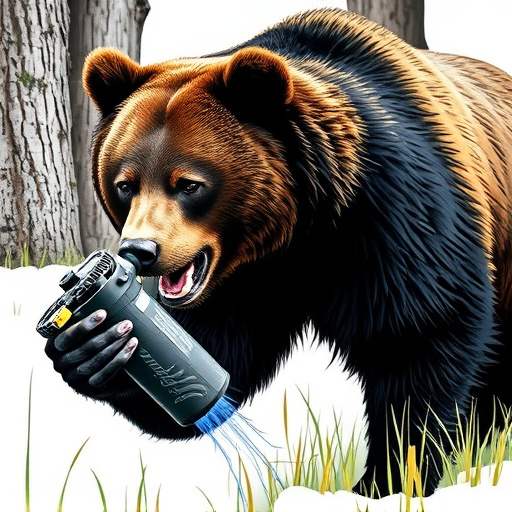Bear spray, a capsaicin-based non-lethal defense mechanism, provides hikers and campers with a crucial buffer during encounters with charging grizzlies. With an effective range of 20-30 feet (6-9 meters), it irritates bears' sensory systems, causing temporary blindness and severe coughing, allowing users to create distance or pause the bear's charge. Understanding its science, factors like wind and terrain that can reduce its range, and proper usage instructions ensures informed decisions in potentially dangerous wildlife situations, proving more effective than running or fighting against aggressive bears.
“Bear spray, a potent deterrent, has been a subject of interest in wildlife management. This article delves into the effectiveness of bear spray as a range-based defense mechanism against charging grizzlies. We’ll explore the chemical composition and action of bear spray, assess its range and impact on aggressive bears, and provide essential safety guidelines for real-world applications. Understanding the dynamics between bear spray and charging grizzlies is crucial for outdoor enthusiasts and conservationists alike.”
- Understanding Bear Spray: The Composition and Its Mechanism
- Assessing the Range: How Effective is Bear Spray Against Charging Grizzlies?
- Real-World Applications and Safety Measures: What You Need to Know
Understanding Bear Spray: The Composition and Its Mechanism
Bear spray, a powerful deterrent, has gained popularity as a means of protection against grizzly bears and other wildlife. Unlike traditional weapons, bear spray relies on a unique chemical composition to disrupt an animal’s behavior. The primary active ingredient is capsaicin, derived from chili peppers, which irritates the bear’s eyes, nose, and respiratory system. When sprayed, it creates a temporary blindness and severe coughing fit, allowing individuals to retreat and escape potential harm.
When compared to the raw power of a charging grizzly, bear spray offers a strategic advantage. Its non-lethal nature makes it a preferred option for hikers, campers, and outdoor enthusiasts. The spray’s range is approximately 30 feet (9 meters), providing a crucial buffer during encounters. Understanding the science behind bear spray ensures that users can make informed decisions in potentially dangerous wildlife situations.
Assessing the Range: How Effective is Bear Spray Against Charging Grizzlies?
Assessing the range of bear spray is crucial when considering its effectiveness against charging grizzlies. The distance at which bear spray can deter an aggressive bear varies depending on several factors, including the user’s skill in application, wind conditions, and the type of spray used. Studies suggest that bear spray can be effective up to 30 feet (9 meters) away, but this range can be reduced by strong winds or rough terrain. When facing a charging grizzly bear, quick reaction time and accurate spray deployment are key to success.
Comparatively, bear spray offers a more accessible deterrant option compared to firearms for non-lethal defense against grizzlies. While it may not stop a determined charge, bear spray can create enough distance or cause the bear to pause, providing the user with a crucial moment to escape. However, direct confrontation with a charging grizzly should be avoided whenever possible, as these powerful animals can inflict severe injuries or even fatalities despite the use of bear spray.
Real-World Applications and Safety Measures: What You Need to Know
In real-world scenarios, bear spray has proven itself as a powerful deterrent against aggressive bears, particularly when compared to the traditional approach of simply running or fighting off a charging grizzly. When used correctly, this non-lethal weapon can create a protective barrier, giving users valuable time to escape potentially dangerous situations. For outdoor enthusiasts and those living in bear country, understanding the spray’s effectiveness and range is crucial for safety.
Bear spray is designed to temporarily blind and disorientate bears, allowing individuals to retreat or seek shelter. The range of effective deterrence varies based on factors such as wind, terrain, and the size of the bear. Typically, a good quality bear spray can be effective up to 20-30 feet (6-9 meters), but this can vary significantly in different conditions. It’s essential for users to familiarize themselves with the specific product’s instructions and range capabilities, ensuring they are prepared when encountering bears in various environments.
Bear spray has established itself as a valuable tool for deterring charging grizzlies, offering an effective range that can provide crucial seconds for escape. However, understanding its limitations, such as the importance of proper usage techniques and the variable factors affecting its reach, is essential when considering bear spray as a primary defense against aggressive bears. Knowing the differences in bear spray effectiveness versus charging grizzly behavior allows individuals to make informed decisions while navigating wild environments, ensuring safety and promoting coexistence with these majestic creatures.
